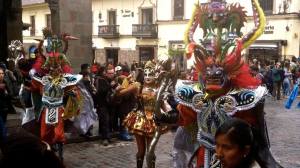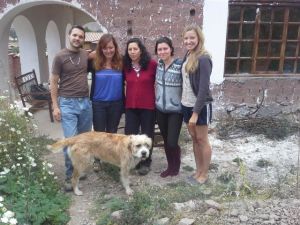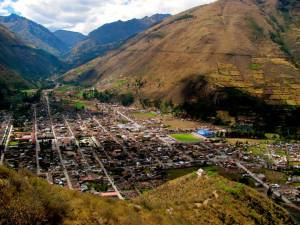The team began interviewing owners of greenhouses in remote Andean communities this week. We rented a car and a driver for the day, and left very early in morning, after stopping by the large market for bread cheese and hot chocolate. In the morning stands selling these things surround the market, each run by a women who has converted an old bicycle into a hot chocolate machine. The front part of the bike is replaced by a large table, under it a propane tank, and around the edges chairs for the customers to sit on. Once breakfast is done, she easily wheels it away to be replaced by a churro stand for the lunch crowd.
We drove again up into the beautiful mountains towards the tiny town of Maucau. When we arrived we found a small group of women guarding huge piles of potatoes. They were freezing them for storage, and while the potatoes sat out in the cold, someone had to keep the neighborhood dogs and chickens away. We sat a while with them, on the cold Maucau earth, searching for a rare spot that was not covered in alpaca poop. After some time we understood our translator was not coming. In that almost everyone in the more distant communities speaks Quechua, this was a vital part of the evaluation. Fortunately our driver stepped in as translator. We asked the questions in Spanish, and he translated into Quechua, and vice versa. A small group of community members had assembled, and we sat together as the sun warmed us, and asked them a series of questions. A Quechua woman came up to us with a bundle wrapped in a towel. Inside was a small quantity of cooked potatoes, which we all shared. It went very well, everyone participating, and offering up good information, and great ideas to think about. After the interview a few people took us to their homes so we could see the greenhouses. While looking at the structures we considered many things, the placement of the building, the materials, how to most effectively prevent the wind from destroying the plastic roof, innovations community members had done for irrigation practices, and the problems with pests. The people again were very welcoming, and we all took some photos together, and then left for Cuncani.
It was my first time in Cuncani, about an hour further into countryside than Maucau. The town seems to be based around the school, houses stretching out along the mountainsides in every direction. We talked to some officials at the school who assured us there was a group of women there waiting to talk to us. We’d put out a radio announcement that we would be coming. We took a seat in the school yard and waited for the group of women to finish washing the dishes from the kids’ lunch. It was recess time and everyone was playing tops, or running around. In the distance the older kids were playing soccer, all the girls wearing the complete traditional Quechua outfit, with a heavy skirt and large hat. When the women finished we talked with them, and realized they didn’t know who we were, and were too busy to talk.
We decided to approach people who we saw had greenhouses. The Urubamba government implemented all the greenhouses in this community. We had a gotten a good deal of information about this program from Freddy the week before. We talked first with an older man who was working behind the school in his field. As we approached, his tiny son clung to his fingers and pant leg. At first he believed us to be a representative from the government, and immediately began to tell us about the community members with greenhouses that still hadn’t received roofing. After we made it clear what we were really there for he showed us his greenhouse. The structure was similar to those in Maucau, but larger. The rock base also had gaps in it, which allowed heat to escape. He discussed the problems with water the community had. All of the city water in this community is chlorinated, which is very bad for the plants. He wished for a system of irrigation that would give him easy access to the river that passed through the town.
Another person we spoke with was a very sweet woman, who tucked her bare legs under herself and sat on the ground while she spun warn onto a wooden spindle. Her greenhouse was growing nothing, because the government had not provided the seeds as they said they would. The nearest place to buy seeds is in Lares, which is two hours away, and the seeds there are very old and difficult to grow.
We also spoke with a young woman and her mother. Their house was situated in the strangest spot in the community. The land in Cuncani is almost barren in the coldness, except for their slightly lower lying house, which is surrounded by lush trees and red flowers. The climate of this house (which is across a small river from the other houses we visited) allows them to use their greenhouse for seedlings, and then move the more mature plants outside. They told us about the workshops they had attended, and said they did little to help with the greenhouses as they are focused more on the overall promotion of nutrition. They also had received no seeds, but had a son who would travel all the way to Urubamba (many hours away by bus) to purchase them.
Friday I left for a four-day adventure to Machu Picchu. I joined a tour group called the Inka Jungle Trail. The first day of the trek was biking. We started out on the top of a mountain, so high and cold we were near the glaciers at the peaks. The ride was entirely downhill, and easy. In the beginning it was hard to appreciate how beautiful the scenery was because it was so cold. Thankfully, after a bit the sun came out, and the elevation lowered. I biked lower and lower on the switch backs of the road, finally entering a jungle climate, where there were small rivers to bike through that would splash your legs, and birds chirping, and bright flowers blooming.
The second day started out with free white water rafting. A girl on my trip didn’t want to go, so she forfeited her ticket, and I got it! We left after breakfast at 6:30 and went down to the Urubamba River, the sacred river. We hopped in the raft and spent the next hour or so drifting, and crashing along the rapids taking in the mountainous scenery. After a quick change of clothes I joined the rest of the tour, who’d been hiking along a road for the last two hours. When I joined we started trekking up the mountainside and into the thick jungle. Mid way through the hike we had a quick break for face painting, done with the seeds of a local plant that is used to dye clothing. We also had a chance to dress up in some traditional Quechua clothing.
We spent the rest of the day hiking up the mountain, pausing at the highest peak of the Inca Trail to look at the Rio Urubamba stretching out in either direction, one way all the way back to the glaciered mountains we’d started at. We hiked down as the sun set, spending twilight zipping across the river in a tiny box that was anchored by two pulleys. After about 7 hours of hiking we walked right into the hot springs of Santa Teresa. I spent the next hour soaking my sore body in the hot water, the almost full moon overhead, surrounded by the mountains.
Day three started with a threat that if we didn’t sign up and pay to go zip lining we would have to suffer the fate of walking for the next 8 hours. Most people were a bit annoyed by the ultimatum and decided on doing the hike. We hiked out of Santa Teresa, back into the mountains, and then along a hot dusty road for a few hours, in a landscape of jagged green mountains and waterfalls. We reached the down of Hidroelectrica, and cut off the road and began walking the infamous railroad tracks into the town of Aguas Caliente. The hike was long, but peaceful, with the PeruRail train interrupting the walk every so often bringing the huge crowds of tourists to Machu Picchu. Late that day, after about 5 hours of hiking we reached the town of Aguas Caliente. Just as the sun was starting to set we could see the huge mountain that cradled Machu Picchu at the top.
Wake up call at 4 am the next day, and we started walking in the dark. We reached a bridge at 5 am, and waited for the large crowds of tourists to pass the entrance gate and begin the 1,700 step hike up to Machu Picchu. It was still completely dark when the hike began, I could only see the steps from the light of the small flashlight, and hear the people around me panting in exhaustion in the humid early morning hours. Midway up I could see the giant gorgeous mountains surrounded me, just coming into focus in the morning light. Finally, we reached the top, and got back into a line of tourists, now joined by those who had opted out of the early morning hike and taken the expensive bus up.
As the sun peeked over the mountain I was standing high above Machu Picchu, taking it all in. The morning was completely clear, and beams of light slowly and individually broke over the crest of the mountain, first striking the humongous mountain just behind the ruins, and then began to blanket the city. A family of llamas was standing casually around me, watching the day begin.
My group was lead on a nice tour, but most of us we too exhausted at this point to pay very close attention. Once the tour ended we recuperated for a moment, lying down in the sunlight and sneaking some breakfast. I spent much of the day sitting in the agricultural sector of the city, in the grass, and gazing out over the landscape of ruins and mountains. It was also at this point when I realized, lamentably, an avocado had exploded in my backpack.
Towards the end of the afternoon I strolled the city again. By this time most of the tourists had left, and for much of the time I found myself completely alone, exploring the city. Every so often I would pass someone sitting peacefully, meditating.
After a painful walk back down the mountain, we spent the rest of the day in the town, waiting for the 9 pm train. We reached Ollayntatambo by train at around 11 pm, and wandered sleepily looking for the van we’d arranged to pick us up. The van could only take us as far as Urubamba, where we got out at midnight, and began to wander looking for a hostel. Things looked grim until we found someone selling hot tea late at night, who told us about a muy tranquilo hostel above a Chinese restaurant. We knocked on the door, and luckily found it open, with beds available.
I got back to Calca this morning, tired and a bit blistered, but happy.
 Chatting with greenhouse owners in Maucau.
Chatting with greenhouse owners in Maucau.
 Working with a Quechua-Spanish translator in Cuncani.
Working with a Quechua-Spanish translator in Cuncani.
 Taking in the view at Macchu Picchu.
Taking in the view at Macchu Picchu.
 Downtown Cusco Parade
Downtown Cusco Parade Team Peru
Team Peru


 Waterfall in Quillabamba
Waterfall in Quillabamba

















